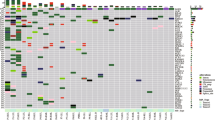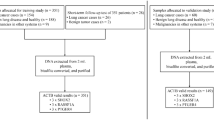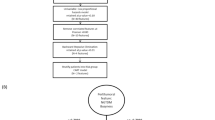Abstract
Computed tomography (CT) screening of lung cancer allows the detection of early tumors. The objective of our study was to verify whether initial asymptomatic lung cancers, identified by high-resolution low-dose CT (LD-CT) on a high-risk population, show genetic abnormalities that could be indicative of the early events of lung carcinogenesis. We analyzed 78 tumor samples: 21 (pilot population) from heavy smokers with asymptomatic non-screening detected early-stage lung cancers and 57 from 5203 asymptomatic heavy smoker volunteers, who underwent a LD-CT screening study. During surgical resection of the detected tumors, tissue samples were collected and short-term cultures were started for karyotype evaluation. Samples were classified according to the normal (NK) or aneuploid (AK) karyotype. The NK samples were further analyzed by the Affymetrix single-nucleotide polymorphisms (SNPs) technology. Metaphase spreads were obtained in 73.0% of the selected samples: 80.7% showed an AK. A statistically significant correlation was found between presence of vascular invasion and abnormal karyotype. A total of 10 NK samples were suitable for SNPs analysis. Subtle genomic alterations were found in eight tumors, the remaining two showing no evidence to date of chromosomal aberrations anywhere in the genome. Two common regions of amplification were identified at 5p and 8p11. Mutation analysis by direct sequencing was conducted for the K-RAS, TP53 and EGFR genes, confirming data already described for heavy smokers. We show that: (i) the majority of screening-detected tumors are aneuploid; (ii) early-stage tumors tend to harbor a less abnormal karyotype; (iii) whole genome analysis of NK tumors allows for the detection of common regions of copy number variation (such as amplifications at 5p and 8p11), highlighting genes that might be considered candidate markers of early events in lung carcinogenesis.
This is a preview of subscription content, access via your institution
Access options
Subscribe to this journal
Receive 50 print issues and online access
$259.00 per year
only $5.18 per issue
Buy this article
- Purchase on Springer Link
- Instant access to full article PDF
Prices may be subject to local taxes which are calculated during checkout

Similar content being viewed by others
References
Beroukhim R, Mermel CH, Porter D, Wei G, Raychaudhuri S, Donovan J et al. (2010). The landscape of somatic copy-number alteration across human cancers. Nature 463: 899–905.
Bianchi F, Hu J, Pelosi G, Cirincione R, Ferguson M, Ratcliffe C et al. (2004). Lung cancers detected by screening with spiral computed tomography have a malignant phenotype when analyzed by cDNA microarray. Clin Cancer Res 10: 6023–6028.
Diederich S, Thomas M, Semik M, Thomas M, Lenzen H, Roos N et al. (2004). Screening for early lung cancer with low dose spiral computed tomography: results of annual follow-up examinations in asymptomatic smokers. Eur Radiol 14: 691–702.
Ding L, Getz G, Wheeler DA, Mardis ER, McLellan MD, Cibulskis K et al. (2008). Somatic mutations affect key pathways in lung adenocarcinoma. Nature 455: 1069–1075.
Ebi H, Sato T, Sugito N, Hosono Y, Yatabe Y, Matsuyama Y et al. (2009). Counterbalance between RB inactivation and miR-17–92 overexpression in reactive oxygen species and DNA damage induction in lung cancers. Oncogene 28: 3371–3379.
Enstrom JE, Heath Jr CW . (1999). Smoking cessation and mortality trends among 118 000 Californians, 1960–1997. Epidemiology 10: 500–512.
Esteller M . (2008). Epigenetics in cancer. N Engl J Med 358: 1148–1159.
Henschke CI, McCauley DI, Yankelevitz DF, Naidich DP, McGuinness G, Miettinen OS et al. (1999). Early lung cancer action project: overall design and findings from baseline screening. Lancet 354: 99–105.
Herbst RS, Heymach JV, Lippman SM . (2008). Lung cancer. N Engl J Med 359: 1367–1380.
Horner MJ, Ries LAG, Krapcho M, Neyman N, Aminou R, Howlader N et al. (2009). SEER Cancer Statistics Review, 1975–2005. National Cancer Institute: Bethesda, MD, http://seer.cancer.gov/csr/1975_2005/, based on November 2008 SEER data submission, posted to the SEER web site, 2009.
Humphrey LL, Teutsch S, Johnson M . (2004). Lung cancer screening with sputum cytologic examination, chest radiography, and computed tomography: an update for the U.S. Preventive Task Force. Ann Intern Med 140: 740–753.
Jemal A, Siegel R, Ward E, Hao Y, Xu J, Murray T et al. (2008). Cancer statistics. CA Cancer J Clin 58: 71–96.
Metz R, Duhadaway JB, Kamasani U, Laury-Kleintop L, Muller AJ, Prendergast GC . (2007). Novel tryptophan catabolic enzyme IDO2 is the preferred biochemical target of the antitumor indoleamine 2,3-dioxygenase inhibitory compound D-1-methyl-tryptophan. Cancer Res 67: 7082–7087.
Miller SA, Dykes DD, Polesky HF . (1988). A simple salting out procedure for extracting DNA from human nucleated cells. Nucleic Acids Res 16: 1215.
Mitsuuchi Y, Testa JR . (2002). Cytogenetics and molecular genetics of lung cancer. Am J Med Genet 115: 183–188.
Mulshine JL, Sullivan DC . (2005). Clinical practice: lung cancer screening. N Engl J Med 352: 2714–2720.
Nannya Y, Sanada M, Nakazaki K, Hosoya N, Wang L, Hangaishi A et al. (2005). A robust algorithm for copy number detection using high-density oligonucleotide single nucleotide polymorphisms genotyping arrays. Cancer Res 65: 6071–6079.
Nguyen-Khac F, Della Valle V, Lopez RG, Ravet E, Mauchauffé M, Friedman AD et al. (2006). Functional analyses of the TEL-ARNT fusion protein underscores a role for oxygen tension in hematopoietic cellular differentiation. Oncogene 25: 4840–4847.
Patel JD, Bach PB, Kris MG . (2004). Lung cancer in US women: a contemporary epidemic. JAMA 291: 1763–1768.
Pelosi G, Sonzogni A, Veronesi G, De Camilli E, Maisonneuve P, Spaggiari L et al. (2008). Pathologic and molecular features of screening low-dose computed tomography (LDCT)-detected lung cancer: a baseline and 2-year repeat study. Lung Cancer 62: 202–214.
Proctor RN . (2001). Tobacco and the global lung cancer epidemic. Nat Rev Cancer 1: 82–86.
Puppala D, Gairola CG, Swanson HI . (2007). Identification of kaempferol as an inhibitor of cigarette smoke-induced activation of the aryl hydrocarbon receptor and cell transformation. Carcinogenesis 28: 639–647.
Shames DS, Girard L, Gao B, Sato M, Lewis CM, Shivapurkar N et al. (2006). A genome-wide screen for promoter methylation in lung cancer identifies novel methylation markers for multiple malignancies. PLoS Med 3: 2244–2263.
Sun S, Schiller JH, Gazdar AF . (2007). Lung cancer in never smokers—a different disease. Nat Rev Cancer 7: 778–790.
Tonon G, Wong KK, Maulik G, Brennan C, Feng B, Zhang Y et al. (2005). High-resolution genomic profiles of human lung cancer. Proc Natl Acad Sci USA 102: 9625–9630.
Uyttenhove C, Pilotte L, Theate I, Stroobant V, Colau D, Parmentier N et al. (2003). Evidence for a tumoral immune resistance mechanism based on tryptophan degradation by indoleamine 2,3-dioxygenase. Nat Med 9: 1269–1274.
Veronesi G, Bellomi M, Veronesi U, Paganelli G, Maisonneuve P, Scanagatta P et al. (2007). Role of positron emission tomography scanning in the management of lung nodules detected at baseline computed tomography screening. Ann Thorac Surg 84: 959–965.
Veronesi G, Bellomi M, Mulshine JL, Pelosi G, Scanagatta P, Paganelli G et al. (2008). Lung cancer screening with low-dose computed tomography: a non-invasive diagnostic protocol for baseline lung nodules. Lung Cancer 61: 340–349.
Weir BA, Woo MS, Getz G, Perner S, Ding L, Beroukhim R et al. (2007). Characterizing the cancer genome in lung adenocarcinoma. Nature 450: 893–898.
Zhao X, Weir BA, LaFramboise T, Lin M, Beroukhim R, Garraway L et al. (2005). Homozygous deletions and chromosome amplifications in human lung carcinomas revealed by single nucleotide polymorphism array analysis. Cancer Res 65: 5561–5570.
Zudaire E, Cuesta N, Murty V, Woodson K, Adams L, Gonzalez N et al. (2008). The aryl hydrocarbon receptor repressor is a putative tumor suppressor gene in multiple human cancers. J Clin Invest 118: 640–650.
Acknowledgements
This study was supported by AIRC (Associazione Italiana per la Ricerca sul Cancro), FUV (Fondazione Umberto Veronesi) and Eredita’ Benilde Viotti. We would like to thank Daniela Brambilla, Raffaella Bertolotti and Giovanna Ciambrone for data managing; Antonio De Vito and Loris Bernard for technical assistance; the Real Time PCR Service at the IFOM-IEO campus for TaqMan assays; Marco Bianchi, Giovanna Maria Jodice, Paolo Nuciforo and the Molecular Pathology Unit at IFOM for samples characterization; Elvira Gerbino for samples preparation; the staff of the IEO Thoracic Surgery and Radiology Departments for clinical assistance; Paola Dalton for manuscript editing; Francesca Toffalorio for helpful discussion.
Author information
Authors and Affiliations
Corresponding authors
Ethics declarations
Competing interests
The authors declare no conflict of interest.
Additional information
Supplementary Information accompanies the paper on the Oncogene website
Rights and permissions
About this article
Cite this article
Belloni, E., Veronesi, G., Micucci, C. et al. Genomic characterization of asymptomatic CT-detected lung cancers. Oncogene 30, 1117–1126 (2011). https://doi.org/10.1038/onc.2010.478
Received:
Revised:
Accepted:
Published:
Issue Date:
DOI: https://doi.org/10.1038/onc.2010.478



